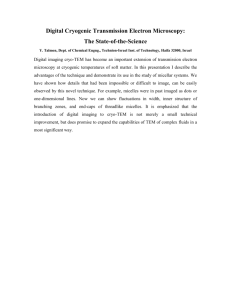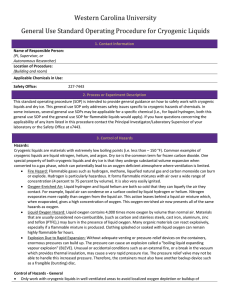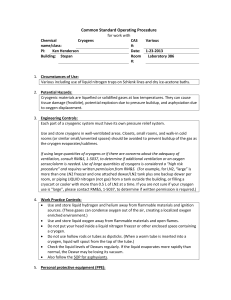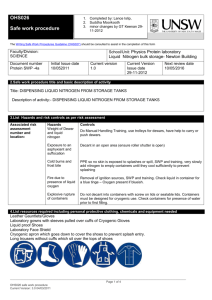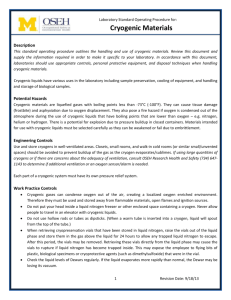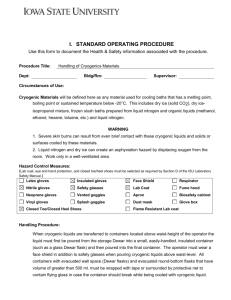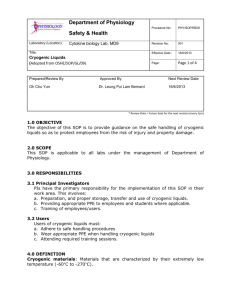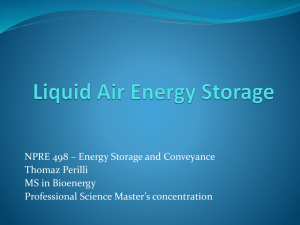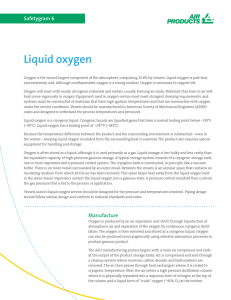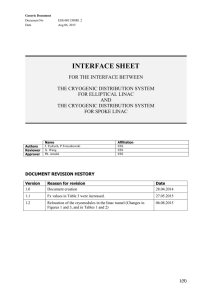UCLA - Environmental Health & Safety
advertisement
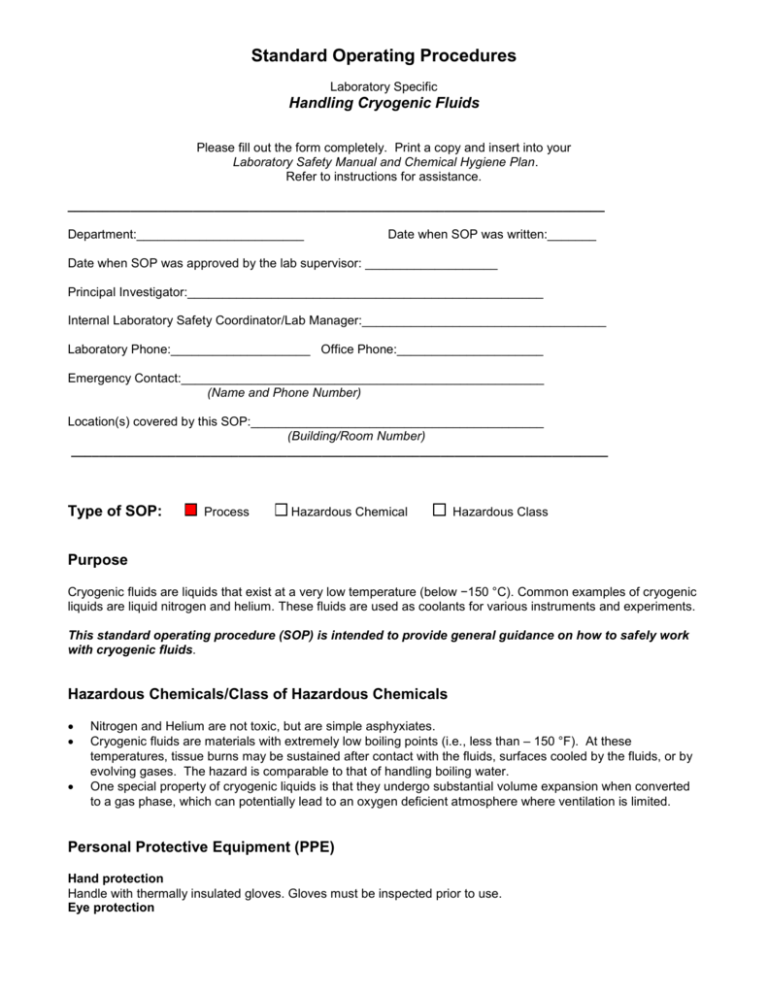
Standard Operating Procedures Laboratory Specific Handling Cryogenic Fluids Please fill out the form completely. Print a copy and insert into your Laboratory Safety Manual and Chemical Hygiene Plan. Refer to instructions for assistance. _____________________________________________________________________________ Department:________________________ Date when SOP was written:_______ Date when SOP was approved by the lab supervisor: ___________________ Principal Investigator:___________________________________________________ Internal Laboratory Safety Coordinator/Lab Manager:___________________________________ Laboratory Phone:____________________ Office Phone:_____________________ Emergency Contact:____________________________________________________ (Name and Phone Number) Location(s) covered by this SOP:__________________________________________ (Building/Room Number) _____________________________________________________________________________ Type of SOP: Process Hazardous Chemical Hazardous Class Purpose Cryogenic fluids are liquids that exist at a very low temperature (below −150 °C). Common examples of cryogenic liquids are liquid nitrogen and helium. These fluids are used as coolants for various instruments and experiments. This standard operating procedure (SOP) is intended to provide general guidance on how to safely work with cryogenic fluids. Hazardous Chemicals/Class of Hazardous Chemicals Nitrogen and Helium are not toxic, but are simple asphyxiates. Cryogenic fluids are materials with extremely low boiling points (i.e., less than – 150 °F). At these temperatures, tissue burns may be sustained after contact with the fluids, surfaces cooled by the fluids, or by evolving gases. The hazard is comparable to that of handling boiling water. One special property of cryogenic liquids is that they undergo substantial volume expansion when converted to a gas phase, which can potentially lead to an oxygen deficient atmosphere where ventilation is limited. Personal Protective Equipment (PPE) Hand protection Handle with thermally insulated gloves. Gloves must be inspected prior to use. Eye protection Wear protective safety glasses. Use equipment for eye protection tested and approved under appropriate government standards such as NIOSH (US) or EN 166(EU). Skin and body protection Long pants, lab coat, and closed toed shoes should be worn when working with cryogenic fluids. Never allow any unprotected part of the body to touch non insulated pipes or vessels which contain cryogenic fluids. The extremely cold metal will cause the flesh to stick fast and tear when one attempts to withdraw from it. Frostbite is likely to occur. Engineering Controls Use cryogenic fluids only in well-ventilated areas. Unconsciousness occurs without warning in an oxygen deficient atmosphere. Neither nitrogen nor helium gas is toxic, but if too much oxygen is displaced by these gases, the danger of asphyxiation is very real! These gases expand their volumes by a factor of ~700 when they are evaporated and allowed to warm up to room temperature. First Aid Procedures If inhaled Persons suffering from lack of oxygen should be moved to fresh air. If victim is not breathing, administer artificial respiration. If breathing is difficult, administer oxygen. Get medical attention immediately. In case of skin contact Remove any clothing that may restrict circulation to frozen area. Do not rub frozen parts as tissue damage may result. As soon as practical, place the affected area in a warm water bath which has a temperature not to exceed 105°F (40°C). Never use dry heat. Call a physician as soon as possible. In case of eye contact Flush the eyes with cool or warm water for fifteen minutes (do not use hot or cold water). Get medical attention immediately. Special Handling and Storage Requirements Store and transport cryogenic fluids only in Dewars or cryogenic liquid cylinders designed for that particular cryogen. Cryogenic liquid dewars are to be stored in well-ventilated areas with the pressure relief valve in the opened position. Spill and Accident Procedure Assess the extent of danger. In the event of a large spill, you should alert others immediately in the vicinity to evacuate, close the doors of the lab if opened, and restrict access to the work area. Do not attempt cleanup if you feel unsure of your ability to do so or if you perceive the risk to be greater than normal laboratory operations. Dial 911 (or 310-825-1491 from cell phone) and EH&S at x59797 for assistance. Medical Emergency Dial 911 or x52111 Life Threatening Emergency, After Hours, Weekends And Holidays – Dial 911 (or 310-8251491 from cell phone) or contact the Ronald Reagan UCLA Medical Center (emergency room) directly at x52111 (located at 757 Westwood Plaza, enter from Gayley Avenue). Note: All serious injuries must be reported to EH&S at x59797 within 8 hours. Non-Life Threatening Emergency – Go to the Occupational Health Facility (OHF), x56771, CHS room 67-120 (This is on the 6th floor, 7th corridor, room 120. Enter through the School of Dentistry on Tiverton Drive and proceed to the “O” elevator to the 6th floor.); Hours: M - F, 7:30 a.m. to 4:30 p.m. At all other times report to Ronald Reagan UCLA Medical Center (emergency room) at x52111. Note: All serious injuries must be reported to EH&S at x59797 within 8 hours. Decontamination/Waste Disposal Procedure For contact and inhalation exposure, see First Aid Measures in Section 8.Return container and unused product to supplier. Do not attempt to dispose of unused product. Material Safety Data Sheet (MSDS) Location (State the location of MSDS) Hardcopy or electronic copy must be available for cryogenic fluids. Online MSDS can be accessed at http://msds.ehs.ucla.edu. Protocol/Procedure 1. Containers for cryogenic liquids must not be closed completely. Although liquid nitrogen and helium are stored in vacuum-jacketed vessels (dewars), there is always some heat leak into the dewar such that there is boil-off of the liquid at all times. Pressure will build up and if no exit is available to the gas, the container would ultimately explode. A pressure relief valve is attached to the dewar to keep the internal pressure very low. Make sure you are aware of the presence of a protective pressure relief valve on any dewar that you handle. 2. If a crack in the metal between the liquid and the vacuum space of a dewar were to occur, a rapid pressure build-up in this relatively confined space will occur since it would no longer be insulated by vacuum. For this reason, all metal dewars must be constructed such that a pressure relief valve or rupture disk connected to the vacuum space will relieve excess pressure prior to sufficient build-up to cause explosion. For the same reason, all glass dewars must be wrapped with tape or netting to prevent flying glass in the event of an explosion. 3. Do not leave openings to cold dewars wide open to the atmosphere for any longer than is absolutely necessary for the manipulations required for transferring liquids. The temperature of liquid nitrogen at atmospheric pressure is -196°C and of liquid helium is -269°C. Air (and its contents) will condense into the dewar and can cause blockages that are potentially dangerous and that will almost certainly interfere with some aspect of the liquid transfer or with the operation of the instrument in the long run. The freezing point of liquid oxygen is -183°C, i.e., above that of these cryogenic fluids. The collection of liquid oxygen into these colder liquids is an explosion hazard! 4. The very cold temperatures of cryogenic fluids necessitate complete avoidance of contact with the skin. Frostbite, i.e. “burns” from extreme cold, will occur very quickly upon contact, especially if clothing, shoes, etc., hold the liquid tightly to the skin. Take care about spills and use appropriate hand protection while transferring these liquids. Use thermally insulated gloves; thin gloves will not help. Take care to avoid contact with the portions of the transfer line that have been inserted into the dewars during the transfer as they will be cold enough to cause cold “burns” for quite a while after removal from the dewars. 5. Liquid helium transfer lines are vacuum jacketed and should not be very cold to touch during the initial cool down of the transfer line. If a transfer line appears to be too cold, it is time to re-pump the vacuum space. The heat of vaporization of liquid helium is very small, i.e., ~10% of that of liquid nitrogen. Thus, helium is never seen as a liquid during transfer operations. A “plume” or “flame” is the indicator that liquid helium is coming through the transfer line during the cool down and is ready to be inserted. Any deviation from this SOP requires approval from PI. Documentation of Training (signature of all users is required) Prior to conducting any work with cryogenic fluids, designated personnel must provide training to his/her laboratory personnel specific to the hazards involved in working with this substance, work area decontamination, and emergency procedures. The Principal Investigator must provide his/her laboratory personnel with a copy of this SOP and a copy of individual cryogenic liquid MSDS provided by the manufacturer. The Principal Investigator must ensure that his/her laboratory personnel have attended appropriate laboratory safety training or refresher training within the last two years. I have read and understand the content of this SOP: Name Signature Date ________________________________ ____________________________ ____________ ________________________________ ____________________________ ____________ ________________________________ ____________________________ ____________ ________________________________ ____________________________ ____________ ________________________________ ____________________________ ____________ ________________________________ ____________________________ ____________ ________________________________ ____________________________ ____________ ________________________________ ____________________________ ____________ ________________________________ ____________________________ ____________ ________________________________ ____________________________ ____________ ________________________________ ____________________________ ____________ ________________________________ ____________________________ ____________ ________________________________ ____________________________ ____________ ________________________________ ____________________________ ____________ ________________________________ ____________________________ ____________ ________________________________ ____________________________ ____________ ________________________________ ____________________________ ____________ ________________________________ ____________________________ ____________ ________________________________ ____________________________ ____________
